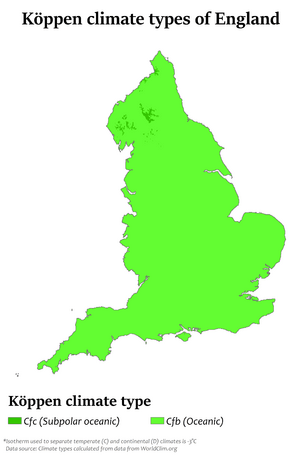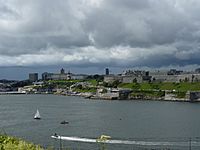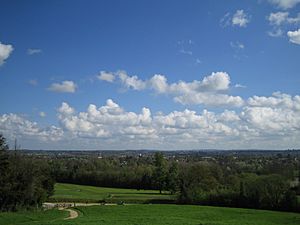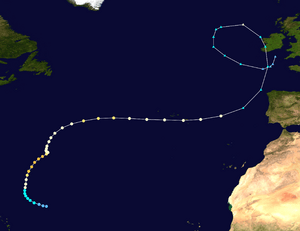Climate of the United Kingdom facts for kids
The United Kingdom is a group of islands located in Europe, between 49° and 61°N latitude. This means it's quite far north! Because of its location, the UK often experiences changeable weather. You might even see many different types of weather in just one day! Generally, the UK's climate is cool, often cloudy, and rainy. Very hot temperatures are not common.
The UK's climate is known as an oceanic climate. This is like the climate in many parts of north-west Europe. The Atlantic Ocean and how far north or south a place is (its latitude) really affect the weather. Areas closer to the Atlantic Ocean, like Northern Ireland, Wales, and western parts of England and Scotland, are usually the mildest, wettest, and windiest. Their temperatures don't change much. Eastern areas are drier, cooler, and less windy. They also have bigger temperature changes between day and night, and between seasons. Northern parts of the UK are generally cooler and wetter.
The UK is mostly affected by cool, moist air coming from the north-west, from the Atlantic. This air mass brings cool, damp weather. Sometimes, especially in summer, there can be a big temperature difference between the far north of Scotland and the south-east of England. This difference can be 10-15°C (18-27°F), or even more! For example, on July 25, 2019, Cambridge in eastern England reached 38.7°C (101.7°F), while the Northern Isles were only around 15°C (59°F).

Contents
England's Weather

England usually has warmer high and low temperatures all year compared to other parts of the UK. However, Wales has slightly milder low temperatures in winter, and Northern Ireland has milder high temperatures in early winter. England also gets more sunshine throughout the year. Its sunniest month is July, with about 193.5 hours of sunshine.
It rains less often in England than in the rest of the UK. The total rainfall is also lower each month. May is the driest month, with about 58.4 mm (2.3 inches) of rain. Strong winds (gales) are less common in England than in Scotland. However, strong winds can happen, and sometimes even the remains of Atlantic hurricanes can reach the UK, causing damage.
| England Weather Averages | ||||||||||||||
|---|---|---|---|---|---|---|---|---|---|---|---|---|---|---|
| Month | Jan | Feb | Mar | Apr | May | Jun | Jul | Aug | Sep | Oct | Nov | Dec | Year | |
| Average maximum temperature °C (°F) |
6.9 (44.4) |
7.2 (45.0) |
9.8 (49.6) |
12.4 (54.3) |
15.8 (60.4) |
18.6 (65.5) |
20.9 (69.6) |
20.7 (69.3) |
17.9 (64.2) |
13.9 (57.0) |
9.9 (49.8) |
7.2 (45.0) |
13.5 (56.3) |
|
| Average minimum temperature °C (°F) |
1.3 (34.4) |
1.1 (34.0) |
2.6 (36.7) |
3.9 (39.0) |
6.7 (44.1) |
9.5 (49.1) |
11.7 (53,1) |
11.5 (52.7) |
9.6 (49.3) |
6.9 (44.4) |
3.8 (38.8) |
1.6 (34.9) |
5.9 (42.6) |
|
| Sunshine hours |
54.2 | 74.3 | 107.6 | 155.2 | 190.6 | 182.6 | 193.5 | 182.5 | 137.2 | 103.1 | 64.5 | 47.3 | 1492.7 | |
| Rainfall mm (inches) |
82.9 (3.3) |
60.3 (2.4) |
64.0 (2.5) |
58.7 (2.3) |
58.4 (2.3) |
61.8 (2.4) |
62.6 (2.5) |
69.3 (2.7) |
69.7 (2.7) |
91.7 (3.6) |
88.2 (3.5) |
87.2 (3.4) |
854.8 (33.7) |
|
| Rainfall ≥ 1 mm days |
13.2 | 10.4 | 11.5 | 10.4 | 9.9 | 9.6 | 9.5 | 9.9 | 9.9 | 12.6 | 13.1 | 12.7 | 132.8 | |
| Source: Met Office (1981–2010 averages) | ||||||||||||||
Northern Ireland's Weather
Northern Ireland is warmer than Scotland throughout the year. Its maximum temperatures are milder than in Wales from December to April. They are also milder than in England from December to February. However, Northern Ireland is cooler during the rest of the year.
Northern Ireland gets more sunshine than Scotland every month. But it gets less sunshine than England and Wales. It is also drier and has fewer rainy days than Scotland, except in May. Northern Ireland is drier than Wales every month, but it rains on more days there. The rainiest month is January, with about 17.8 days having more than 1 mm (0.04 inches) of rain.
| Northern Ireland Weather Averages | ||||||||||||||
|---|---|---|---|---|---|---|---|---|---|---|---|---|---|---|
| Month | Jan | Feb | Mar | Apr | May | Jun | Jul | Aug | Sep | Oct | Nov | Dec | Year | |
| Average maximum temperature °C (°F) | 6.7 (44.1) |
7.1 (44.8) |
8.9 (48.0) |
11.1 (52.0) |
14.2 (57.6) |
16.5 (61.7) |
18.4 (65.1) |
18.1 (64.6) |
15.7 (60.3) |
12.5 (54.5) |
9.2 (48.6) |
7.5 (45.5) |
12.2 (54.0) |
|
| Average minimum temperature °C (°F) | 1.2 (34.2) |
1.2 (34.2) |
2.3 (36.1) |
3.3 (37.9) |
5.6 (42.1) |
8.3 (46.9) |
10.6 (51.1) |
10.2 (50.4) |
8.3 (46.9) |
6.1 (43.0) |
3.1 (37.6) |
2.0 (35.6) |
5.2 (41.4) |
|
| Sunshine hours |
41.0 | 60.1 | 90.0 | 140.8 | 175.9 | 150.9 | 139.6 | 138.0 | 113.1 | 85.5 | 52.8 | 31.9 | 1219.7 | |
| Rainfall mm (inches) |
119.1 (4.7) |
86.5 (3.4) |
93.4 (3.7) |
70.6 (2.8) |
68.1 (2.7) |
72.1 (2.8) |
73.2 (2.9) |
90.8 (3.6) |
94.4 (3.7) |
114.5 (4.5) |
110.5 (4.4) |
118.5 (4.7) |
1111.6 (43.8) |
|
| Rainfall ≥ 1 mm days |
17.8 | 14.1 | 16.4 | 12.4 | 12.6 | 12.4 | 13.1 | 13.9 | 14.4 | 16.4 | 16.7 | 16.9 | 177.0 | |
| Source: Met Office (1971–2000 averages) | ||||||||||||||
Scotland's Climate
Scotland has the coolest weather in the UK all year round. In January, the average lowest temperature is -0.2°C (31.6°F). Scotland is also the wettest country in the UK for most months. The wettest month is January, with about 170.5 mm (6.7 inches) of rain. Scotland is also the cloudiest country for most of the year.
| Weather chart for Scotland 1971-2000 | |||||||||||||||||||||||||||||||||||||||||||||||
|---|---|---|---|---|---|---|---|---|---|---|---|---|---|---|---|---|---|---|---|---|---|---|---|---|---|---|---|---|---|---|---|---|---|---|---|---|---|---|---|---|---|---|---|---|---|---|---|
| J | F | M | A | M | J | J | A | S | O | N | D | ||||||||||||||||||||||||||||||||||||
|
171
5
-0
|
123
5
-0
|
139
7
1
|
86
9
2
|
79
13
5
|
85
15
7
|
92
17
9
|
107
17
9
|
140
14
7
|
163
11
5
|
166
7
2
|
170
6
1
|
||||||||||||||||||||||||||||||||||||
| temperatures in °C precipitation totals in mm |
|||||||||||||||||||||||||||||||||||||||||||||||
|
Imperial conversion
|
|||||||||||||||||||||||||||||||||||||||||||||||
| Scotland Weather Averages | ||||||||||||||
|---|---|---|---|---|---|---|---|---|---|---|---|---|---|---|
| Month | Jan | Feb | Mar | Apr | May | Jun | Jul | Aug | Sep | Oct | Nov | Dec | Year | |
| Average maximum temperature °C (°F) | 5.0 (41.0) |
5.2 (41.4) |
6.9 (44.4) |
9.3 (48.7) |
12.8 (55.0) |
14.9 (58.8) |
16.9 (62.4) |
16.6 (61.9) |
13.9 (57.0) |
10.8 (51.4) |
7.4 (45.3) |
5.7 (42.3) |
10.5 (50.9) |
|
| Average minimum temperature °C (°F) | -0.2 (31.6) |
-0.1 (31.8) |
0.9 (33.6) |
2.1 (35.8) |
4.5 (40.1) |
7.2 (45.0) |
9.3 (48.7) |
9.2 (48.6) |
7.2 (45.0) |
4.9 (40.8) |
2.0 (35.6) |
0.5 (32.9) |
4.0 (39.2) |
|
| Sunshine hours |
30.8 | 58.1 | 87.6 | 128.2 | 173.2 | 153.2 | 145.0 | 137.5 | 104.4 | 74.5 | 43.2 | 24.7 | 1160.4 | |
| Rainfall mm (inches) |
170.5 (6.7) |
123.4 (4.9) |
138.5 (5.5) |
86.2 (3.4) |
79.0 (3.1) |
85.1 (3.4) |
92.1 (3.6) |
107.4 (4.2) |
139.7 (5.5) |
162.6 (6.4) |
165.9 (6.5) |
169.6 (6.7) |
1520.1 (59.8) |
|
| Rainfall ≥ 1 mm days |
18.6 | 14.8 | 17.3 | 13.0 | 12.2 | 12.7 | 13.3 | 14.1 | 15.9 | 17.7 | 17.9 | 18.2 | 185.8 | |
| Source: Met Office (1971–2000 averages) | ||||||||||||||
Wales's Weather
Wales has warmer temperatures all year than Scotland. It also has milder winter low temperatures than England. However, its winter high temperatures are cooler than Northern Ireland's. Wales is wetter than Northern Ireland and England throughout the year. But it has fewer rainy days than Northern Ireland, meaning the rain tends to be heavier when it falls.
Wales is also drier than Scotland for most months. It has fewer rainy days than Scotland. Wales gets more sunshine than Scotland and Northern Ireland, but less than England. May is the sunniest month, with about 186.8 hours of sunshine.
| Weather chart for Wales 1971-2000 | |||||||||||||||||||||||||||||||||||||||||||||||
|---|---|---|---|---|---|---|---|---|---|---|---|---|---|---|---|---|---|---|---|---|---|---|---|---|---|---|---|---|---|---|---|---|---|---|---|---|---|---|---|---|---|---|---|---|---|---|---|
| J | F | M | A | M | J | J | A | S | O | N | D | ||||||||||||||||||||||||||||||||||||
|
158
7
1
|
114
7
1
|
119
9
2
|
86
11
3
|
81
15
6
|
86
17
9
|
78
19
11
|
106
19
11
|
124
16
9
|
153
13
7
|
157
9
4
|
173
7
2
|
||||||||||||||||||||||||||||||||||||
| temperatures in °C precipitation totals in mm |
|||||||||||||||||||||||||||||||||||||||||||||||
|
Imperial conversion
|
|||||||||||||||||||||||||||||||||||||||||||||||
| Wales Weather Averages | ||||||||||||||
|---|---|---|---|---|---|---|---|---|---|---|---|---|---|---|
| Month | Jan | Feb | Mar | Apr | May | Jun | Jul | Aug | Sep | Oct | Nov | Dec | Year | |
| Average maximum temperature °C (°F) | 6.5 (43.7) |
6.6 (43.9) |
8.6 (47.5) |
11.0 (51.8) |
14.5 (58.1) |
16.8 (62.2) |
19.1 (66.4) |
18.8 (65.8) |
16.2 (61.2) |
12.8 (55.0) |
9.3 (48.7) |
7.4 (45.3) |
12.3 (54.1) |
|
| Average minimum temperature °C (°F) | 1.3 (34.3) |
1.1 (34.0) |
2.4 (36.3) |
3.4 (38.1) |
6.0 (42.8) |
8.6 (47.5) |
10.9 (51.6) |
10.7 (51.3) |
8.8 (47.8) |
6.5 (43.7) |
3.7 (38.7) |
2.2 (36.0) |
5.5 (41.9) |
|
| Sunshine hours |
42.8 | 63.4 | 94.2 | 148.0 | 186.8 | 167.0 | 181.8 | 168.7 | 125.8 | 90.4 | 54.9 | 35.4 | 1359.3 | |
| Rainfall mm (inches) |
158.4 (6.2) |
113.8 (4.5) |
118.5 (4.7) |
85.7 (3.4) |
80.6 (3.2) |
86.0 (3.4) |
78.3 (3.1) |
105.8 (4.2) |
123.8 (4.9) |
152.9 (6.0) |
156.6 (6.2) |
173.1 (6.8) |
1433.5 (56.4) |
|
| Rainfall ≥ 1 mm days |
17.4 | 13.4 | 15.1 | 11.7 | 11.5 | 11.4 | 10.3 | 12.2 | 13.0 | 15.8 | 16.7 | 17.1 | 165.5 | |
| Source: Met Office (1971–2000 averages) | ||||||||||||||
Seasons in the UK
Spring Weather (March to May)
Spring in the UK is usually calm, cool, and dry. This is because the Atlantic Ocean has lost much of its warmth from the colder months. As the sun gets higher and days get longer, temperatures can rise. But they often drop again at night because the ocean is still cool. Sometimes, thunderstorms and heavy showers can happen, especially later in spring.
Snow can still fall in early spring, especially in March, when temperatures are colder. It's not unusual for snow to fall until mid-April. Sometimes, it has even snowed in mid-May in some areas! Early spring can be quite cold, and sometimes the lowest temperatures of the year happen in March.
The average temperatures in spring are different depending on how far north you are. Scotland and the mountains of Wales and northern England are the coolest. Southern England has the warmest spring temperatures.
Summer Weather (June to August)
Summer is from June to August. It's the warmest and usually the sunniest season. How much rain falls can vary a lot because of local thunderstorms. These storms happen mostly in southern, eastern, and central England. They are less common in the north and west.
Temperatures are highest in southern and central areas and lowest in the north. Summer temperatures rarely go above 35°C (95°F). When they do, it's usually in London and the South East. Scotland and northern England have the coolest summers. Wales and the south-west of England have warmer summers. The south and south-east of England have the warmest summers. The highest temperature ever recorded in the UK was 38.5°C (101.3°F) in Faversham, Kent, on August 10, 2003.
Sometimes, very high temperatures happen for just a day or two. This is when warm air is pulled over the country from the south. This can often lead to heavy thunderstorms.
Some summers in the 21st century have been long and hot, like 2003, 2006, and 2013. Others are remembered for flooding from heavy rain, like 2007 and 2012. Even with mixed summers, temperatures of 30°C (86°F) or above have been recorded somewhere in the UK every year since 1993.
Autumn Weather (September to November)
Autumn in the UK is from September to November. This season is known for unsettled weather. Cool air from the north meets warm air from the tropics, causing a lot of stormy conditions. Also, the ocean is still warm from summer, which adds to the unsettled weather. When the air is very cold, it can cause a lot of clouds and rain.
Strong storms from the Atlantic can become very powerful in autumn. Winds can reach hurricane force (over 119 km/h or 74 mph). Western areas, being closer to the Atlantic, get these severe conditions more often. So, autumn, especially later in the season, is often the stormiest time of the year.
Autumn can also be cold. Very low temperatures and heavy snow have been recorded in November in some years. The first frosts of winter usually happen between October and December. However, September can sometimes be warmer than June, as it was in 1999.
The UK sometimes has an 'Indian Summer'. This is when temperatures, especially at night, stay very mild. This happens because the surrounding ocean is still warm, keeping the country in warm air. Autumns since 2000 have been very mild, but also with very wet or very dry periods.
Coastal areas in southern England have the warmest autumns. Mountainous areas of Wales, northern England, and most of Scotland have cooler autumns.
Winter Weather (December to February)
Winter in the UK is from December to February. It's generally cool, wet, and windy. Night temperatures rarely drop below -10°C (14°F), and daytime temperatures rarely go above 15°C (59°F). There's a lot of rain, but snow is not very common. The only areas with a lot of snow are the Scottish Highlands and the Pennines mountains. In these higher places, snow can stay on the ground for 1-5 months, or even longer.
Later in winter, the weather often becomes more stable. There's less wind, less rain, and lower temperatures. This is especially true near the coasts because the Atlantic Ocean is at its coldest then. However, early winter is often unsettled and stormy. It's usually the wettest and windiest time of the year.
Snow falls almost every year but usually not much. It mainly affects northern and eastern areas, and high ground in Wales and Scotland. In Scotland's mountains, there's often enough snow for skiing at one of the five Scottish ski resorts. These resorts are usually open from December to April. When winds are light and there's high pressure, frost and fog can be a problem, making driving dangerous.
The coldest areas in winter are the mountains of Wales and northern England, and inland parts of Scotland. Coastal areas, especially in the south and west, have the mildest winters.
The UK can have very cold winters, like in 1684, 1740, 1795, 1947, and 1963. In 1963, snow lasted in most areas until March. In recent times, snow has become rarer. However, the UK can still get heavy snowfalls, like in 2008/09, 2009/10, and 2010/11. December 2010 was the coldest December in 120 years.
In the 1990s and 2000s, most winters were milder and wetter than average. But since 2008, there have been three cold winters in a row. Since winter 2012/2013, winters have been mild but very wet. December 2015 was the wettest month ever recorded in the UK. It was also the warmest December on record for the whole UK.
Sunshine and Clouds
The UK gets about 1339.7 hours of sunshine each year. This is less than 30% of the total possible sunshine. The south coast of England often has the clearest skies. This is because clouds usually form over land, and winds from the south-west keep them away from the coast. The counties of Dorset, Hampshire, Sussex, and Kent are the sunniest areas. They get around 1,750 hours of sunshine per year, and many southern coastal areas get over 2000 hours.

Northern, western, and mountainous areas are generally the cloudiest. Some mountainous areas get less than 1,000 hours of sunshine a year. Valleys, like the South Wales Valleys, get less sunshine because the mountains block the sun in the morning and evening. This is very noticeable in winter. The mountains of Wales, northern England, and Scotland can be very cloudy with a lot of fog. Fog can also form near the coast in spring and early summer.
Sometimes, large high-pressure systems can stay over the UK for weeks or months. This brings clear skies and few clouds. In winter, this means frosty nights. In summer, it means hot days, and some coastal areas can get almost maximum possible sunshine.
The Atlantic Ocean's Influence
The Atlantic Ocean has a huge effect on the UK's climate. The North Atlantic Current brings warm water from the Gulf of Mexico to the waters around the UK. This makes the UK's climate much milder and warmer. If this current didn't exist, winter temperatures would be about 10°C (18°F) colder than they are now! This warm current allows places in England to have vineyards at the same latitude where Canada has polar bears.
These warm ocean currents also bring a lot of moisture. This is why western parts of the UK are so wet.
Winds in the UK
Because the UK is far north and close to a large ocean, it experiences strong winds. The most common wind direction is from the south-west. Winds are strongest near western coasts and exposed areas.
Strong winds, called gales (speeds of 51 to 101 km/h or 32 to 63 mph), often happen when deep low-pressure systems cross the country. The Hebrides in Scotland experience about 35 days of gales a year. Inland areas in England and Wales get fewer than 5 days of gales a year. Higher places tend to have stronger winds. For example, Great Dun Fell in Cumbria averaged 114 days of gales a year.
The highest wind gust recorded at a low level in England was 191 km/h (119 mph) in Cornwall. In Scotland, a gust of 142 mph (229 km/h) was recorded in Fraserburgh. Wales's highest gust was 124 mph (200 km/h) in Rhoose. Very powerful storms usually affect the UK in autumn and winter.
Rainfall Patterns
Rainfall varies a lot across the UK. Generally, the further west you go and the higher the land, the more rain there is. The mountains of Wales, Scotland, the Pennines in northern England, and the moors of south-west England are the wettest parts. Some of these places can get as much as 4577 mm (180 inches) of rain annually, making them some of the wettest in Europe. The wettest spot in the UK is Crib Goch in Snowdonia, which gets about 4473 mm (176 inches) of rain a year.
Most of the UK's rain comes from low-pressure systems that move in from the west or south-west. These are especially frequent in autumn and winter. They can bring long periods of heavy rain, and flooding is quite common.
Some parts of England are surprisingly dry. London gets just under 650 mm (25.6 inches) of rain per year, which is less than cities like Rome or New York City. In East Anglia, it typically rains on about 113 days a year. Most of the south, south-east, and East Anglia receive less than 700 mm (27.6 inches) of rain per year. The driest areas are in Essex and Cambridgeshire, with around 600 mm (23.6 inches) annually. This is because mountains to the west block some of the moist air.
The UK has had drought problems in recent years, especially from 2004-2006. Fires broke out, and water restrictions were put in place. The drought ended with very heavy rainfall from October 2006 to January 2007. December 2015 was the wettest month ever recorded in the UK.
Temperature Overview
The UK generally has cool to mild winters and warm summers. Temperatures don't change drastically throughout the year. In England, the average yearly temperature ranges from 8.5°C (47.3°F) in the north to 11°C (51.8°F) in the south. This small change is mostly because the Atlantic Ocean keeps temperatures moderate. Water heats up and cools down slowly, warming coastal areas in winter and cooling them in summer.
The ocean is coldest in February or early March. So, near the coast, February is often the coldest month. Inland, January and February are both very cold. The lowest temperatures happen on clear, calm winter nights inland, especially with snow on the ground. Sometimes, very cold air from the poles or continent can be pulled over the UK, bringing freezing weather.
Valley floors away from the sea can be very cold as dense, cold air sinks into them. The coldest temperature recorded in England and Wales was -26.1°C (-15°F) in Edgmond, Shropshire, on January 10, 1982.
The warmest winter temperatures usually occur on the south and west coasts. However, warm temperatures can sometimes happen in northern Scotland due to a "foehn wind." This is a warm, dry wind that blows down the side of mountains.
July is usually the warmest month. The highest temperatures tend to be away from the Atlantic, in southern, eastern, and central England. Here, summer temperatures can go above 30°C (86°F). The highest temperature ever recorded in the UK was 38.5°C (101.3°F) in Faversham, Kent, on August 10, 2003.
| Absolute Temperature Records | ||||||
|---|---|---|---|---|---|---|
| Country | Highest Temperatures | Lowest Temperatures | ||||
| °C | °F | Location and Date | °C | °F | Location and Date | |
| England | 38.5 | 101.3 | Faversham, Kent on 10 August 2003 | |||
| Wales | 35.2 | 95.4 | Hawarden Bridge, Flintshire on 2 August 1990 | |||
| Scotland | 32.9 | 91.2 | Greycrook, Scottish Borders on 9 August 2003 | |||
| Northern Ireland | 30.8 | 87.4 | Knockarevan, Fermanagh on 30 June 1976; Belfast on 12 July 1983 | |||
Severe Weather Events
While the UK isn't famous for extreme weather, it does happen. Events like floods and droughts can occur. For example, the summer of 1976 had temperatures as high as 35°C (95°F). It was so dry that the country suffered from drought and water shortages.
Long periods of extreme weather, like droughts or very cold winters, are often caused by large high-pressure systems. These can stay for days, weeks, or even months. In winter, they bring cold, dry weather. In summer, they bring hot, dry weather.
There have also been severe flash floods from very heavy rain. The worst was the Lynmouth disaster in 1952, where 34 people died. In 2004, a severe flash flood hit Boscastle in Cornwall. However, the worst floods in modern UK history were the North Sea flood of 1953. A powerful storm caused a huge storm surge that killed over 300 people in eastern England.
Thunderstorms are most common in southern and eastern England. They are least common in the north and west. In London, thunderstorms happen about 14-19 days a year. In Northern Ireland and western Scotland, they happen around 3 days a year. Sometimes, thunderstorms can be severe and produce large hailstones.
Strong winds mainly occur in autumn and winter. Scotland experiences hurricane-force winds in most winters. The Great Storm of 1987 and the Burns' Day storm of 1990 were very severe examples.
The most rain recorded in a single day was 279 mm (11 inches) in Martinstown, Dorset, on July 18, 1955. Heavy rain in June 2007 caused widespread flooding, killing four people and causing over £1.5 billion in damage.
Tropical cyclones (hurricanes) themselves don't hit the UK because the seas are too cold. They need water temperatures above 26.5°C (79.7°F) to stay strong. Any tropical cyclone that comes near the UK changes into an extratropical cyclone. The UK experiences these frequently. The Great Storm of 1987 contained the remains of Hurricane Floyd. Hurricanes Lili (1996) and Gordon (2006) both crossed the UK as strong extratropical cyclones, causing transport problems, power cuts, and flooding.
Tornadoes in the UK
The UK actually has the highest number of tornadoes per land area of any country in the world! It gets at least 33 tornadoes every year. Most tornadoes are weak, but some can cause a lot of damage. For example, the Birmingham tornado of 2005 and the London tornado of 2006 both caused significant damage and injuries. The largest ever recorded was thought to be an F4 tornado in London in 1091.
The UK also holds the record for the largest tornado outbreak outside of the United States. On November 23, 1981, 105 tornadoes formed from a cold front in just over 5 hours! Luckily, most of these tornadoes were short-lived and weak, and no one died.
UK Climate History
The UK's climate has changed a lot over time. In the past, it was much warmer or much colder. The last glacial period, which ended about 10,000 years ago, was a time of extreme cold. During this time, a huge ice sheet covered most of the UK, except for southern England and parts of Wales.
A cold period from the 16th to the mid-19th centuries is known as the Little Ice Age.
Temperature records in England go back to the mid-17th century. The Central England Temperature (CET) record is the oldest in the world. It combines records from several places in central England.
Over the last century, the UK has seen a warming trend in temperatures. The decade from 2000-2009 was the warmest since records began in 1850. This warming trend is shown by comparing temperature data from different time periods.
Images for kids
-
Köppen climate types in England
-
Köppen climate types in Scotland
-
Hardiness zones in the British Isles. These zones help show where different plants can grow.
-
Cambridge Botanic Garden Weather Station, where a very high temperature was once recorded.
See also
 In Spanish: Clima del Reino Unido para niños
In Spanish: Clima del Reino Unido para niños









